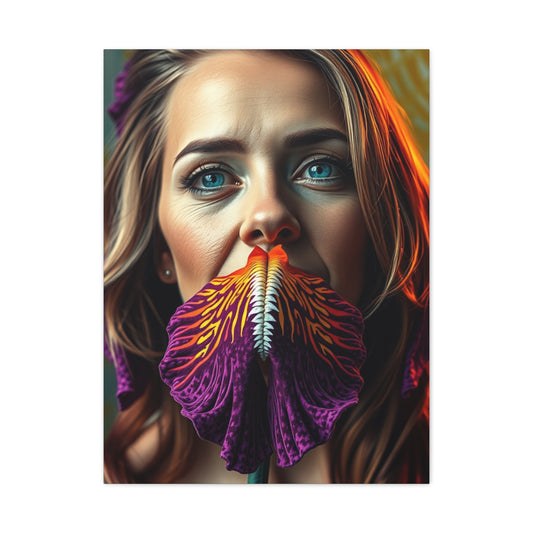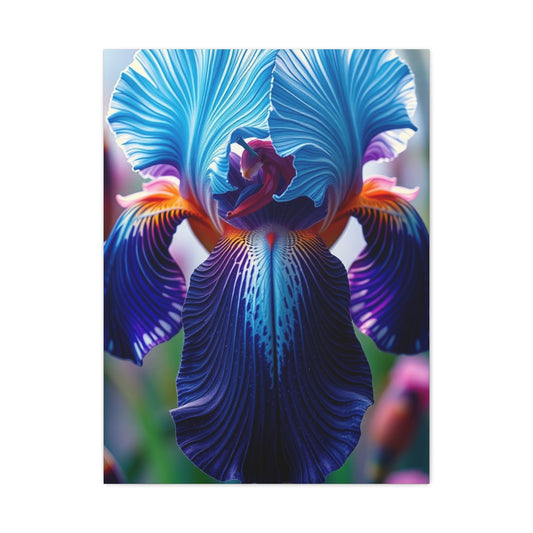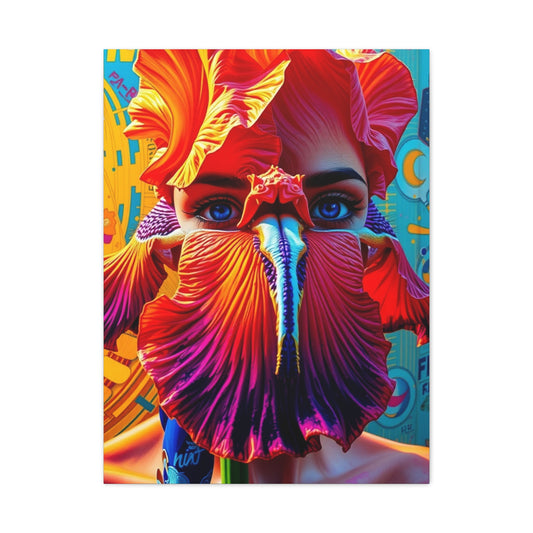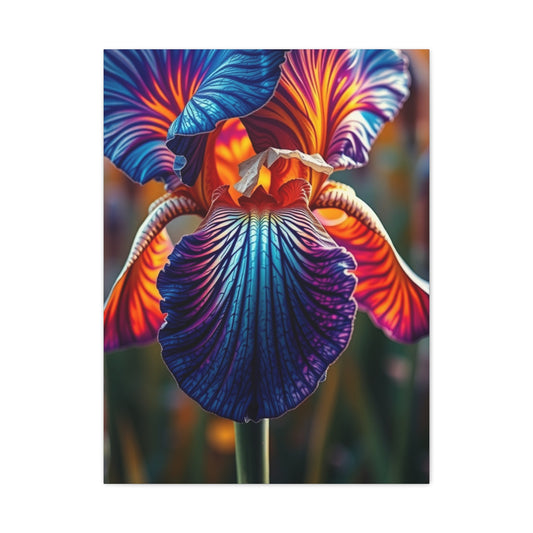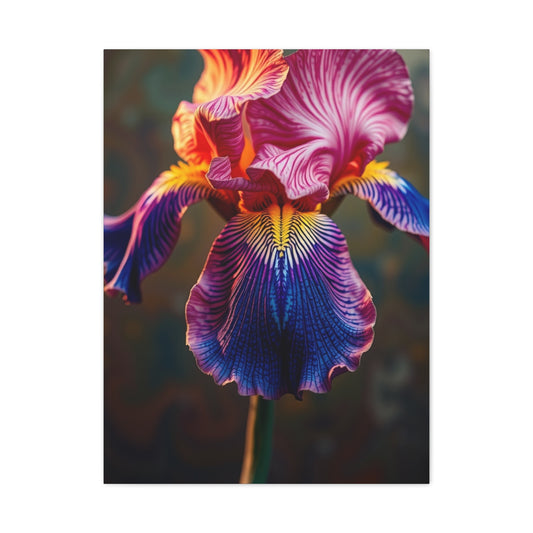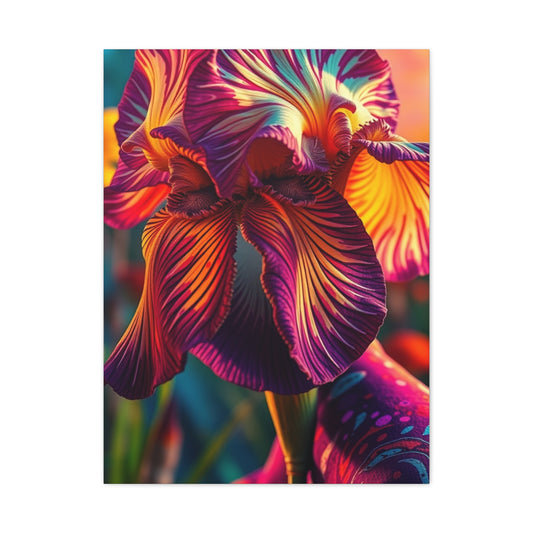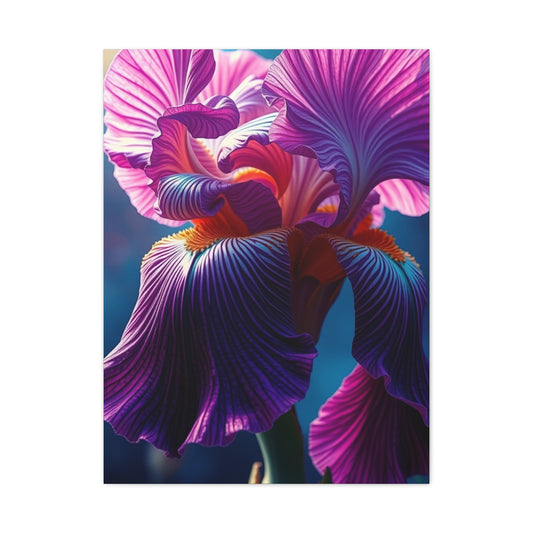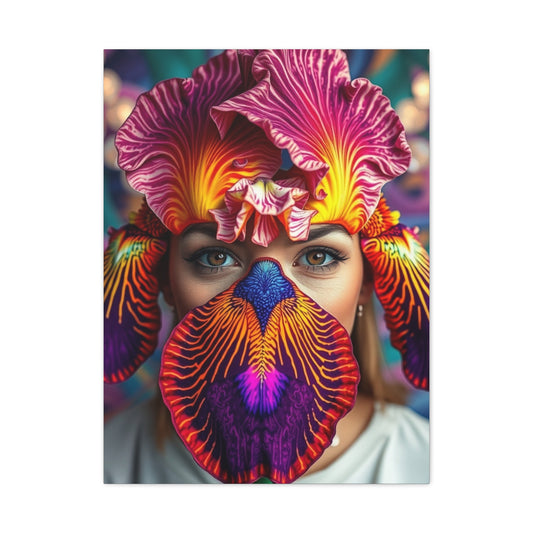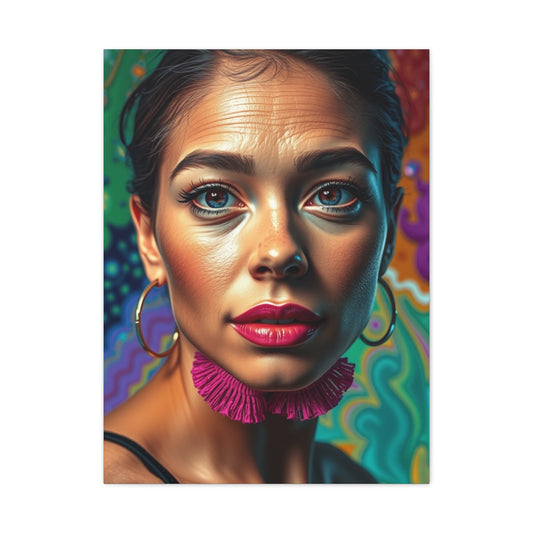The Visionary World of Iris Scott: Elevating Contemporary Wall Art
In the contemporary art landscape, few artists command attention and admiration quite like Iris Scott, whose groundbreaking approach has permanently reshaped the boundaries of modern creative expression. Unlike traditional painters who rely on brushes, palette knives, or other conventional tools, Scott has embraced the immediacy and intimacy of finger painting as her primary medium. Through this innovative technique, she produces artworks that pulse with a unique vitality, offering viewers an emotional and sensory experience that is both immediate and immersive.
The essence of Scott’s work lies in her ability to merge raw, tactile engagement with a refined artistic vision. Every stroke made with her fingers carries a sense of immediacy, intimacy, and spontaneity that mechanical tools cannot replicate. This direct connection between artist and canvas translates into a visual language imbued with emotion, energy, and human touch. By literally placing herself into the painting process, Scott elevates finger painting—often dismissed as a childish or amateur technique—into a sophisticated form of contemporary art that rivals traditional methodologies in both complexity and depth.
Her compositions often feature vivid, kaleidoscopic color palettes that draw the viewer into a dynamic interplay of light, texture, and movement. The colors blend and swirl organically under the influence of her fingertips, creating mesmerizing gradients and textures that feel alive. Whether depicting ethereal floral arrangements, abstract landscapes, or emotionally charged figurative works, Scott’s pieces convey a vibrancy and authenticity that invites prolonged contemplation. Unlike traditional brushwork, where every stroke can feel controlled or deliberate, her finger-painted canvases exude a sense of spontaneity, emphasizing process as much as the final composition.
Scott’s contributions to contemporary wall art extend beyond the aesthetic; they challenge preconceived notions about artistic technique, sophistication, and value. By demonstrating that finger painting can produce works of substantial technical merit and emotional resonance, she inspires both emerging artists and established creatives to reconsider their own approaches. Interior designers, collectors, and art enthusiasts alike are drawn to her work not only for its visual appeal but for the statement it makes about innovation, risk-taking, and the power of human touch in art. Her pieces often become focal points in spaces, transforming interiors into vibrant, interactive environments where emotion and creativity intersect.
Moreover, Scott’s artistic philosophy resonates with a broader cultural movement that values authenticity, human connection, and experiential engagement. In an era dominated by digital reproduction, mechanical precision, and mass-produced visuals, her finger-painted works serve as reminders of the power of direct human expression. The tactile nature of her art encourages viewers to experience it beyond mere observation; it becomes a multisensory engagement where texture, color, and composition communicate on an instinctual level.
In addition to the aesthetic and conceptual significance, Iris Scott has also influenced how contemporary art is presented and perceived in commercial and residential interiors. Her works seamlessly integrate into a wide range of design schemes—from minimalist modern apartments seeking a pop of color and movement, to eclectic homes craving the warmth of human expression, to corporate spaces aiming to inspire creativity and emotional resonance. Each piece, with its depth and luminosity, becomes more than wall décor—it transforms a room into a living, breathing gallery that reflects personality, energy, and artistic innovation.
Childhood Creativity to Professional Art
The transformation of finger painting from a simple childhood pastime into a legitimate and highly respected art form represents one of the most fascinating developments in contemporary artistic practice. This evolution challenges preconceived notions about artistic legitimacy and demonstrates how innovation can emerge from the most unexpected sources.
Traditional art education has long emphasized the importance of mastering various brush techniques, understanding color theory through mechanical application, and developing fine motor skills through tool manipulation. However, this revolutionary approach demonstrates that the human hand, in direct contact with paint, can achieve effects that surpass those created through conventional methods.
The tactile connection between artist and medium creates an unprecedented level of intimacy in the creative process. When fingers make direct contact with paint, the artist experiences an immediate feedback loop that influences every subsequent mark. This direct sensory engagement allows for spontaneous adjustments, subtle pressure variations, and intuitive color blending that would be impossible to achieve through traditional brush work.
Furthermore, the finger painting technique enables the creation of unique textural effects that cannot be replicated through any other method. The natural oils and warmth of human skin interact with paint in ways that create distinctive surface qualities, adding dimensional depth and organic authenticity to each artwork. These subtle variations contribute to the overall visual richness that has become synonymous with this artistic approach.
Define Modern Expressionist Wall Art
The technical innovations employed in contemporary finger painting extend far beyond simple finger application of color. These sophisticated methodologies incorporate elements of impressionism, expressionism, and abstract art to create multi-layered compositions that demand careful examination and reward prolonged contemplation.
One of the most striking aspects of this technique involves the strategic manipulation of paint consistency and application pressure. By varying the amount of paint on fingertips and adjusting the pressure applied to canvas, artists can create everything from delicate whispers of color to bold, dramatic statements that dominate entire compositions. This versatility allows for incredible range within single pieces, creating visual narratives that guide viewers through carefully orchestrated emotional journeys.
The layering techniques employed in these works represent another significant advancement in finger painting methodology. Multiple layers of paint are applied in strategic sequences, with each layer contributing to the overall depth and complexity of the final piece. Lower layers often serve as foundations that influence the visual behavior of subsequent applications, creating optical effects that would be difficult to achieve through traditional painting methods.
Color transition techniques have also reached new levels of sophistication through finger application. The direct contact between skin and paint allows for seamless blending that creates natural gradations and color relationships. These transitions often exhibit organic qualities that mirror natural phenomena, contributing to the overall sense of vitality and movement that characterizes these works.
The Impact of Bold Colors on the Mind
The psychological influence of bold, vibrant colors in artwork reaches far beyond mere visual enjoyment. Studies in environmental psychology and art therapy have consistently highlighted the profound effects that energetic color schemes can have on our mental and emotional states. Highly saturated colors, especially when arranged in dynamic and expressive patterns, can stimulate neural pathways that are closely linked to positive emotional responses. This stimulation often triggers the release of neurotransmitters like dopamine and serotonin, which are associated with feelings of happiness, energy, and optimism. In this sense, bold artwork does more than decorate a space—it actively contributes to enhancing mood and overall psychological well-being.
When these vibrant hues are combined with the tactile, organic qualities of finger-painted or manually manipulated artworks, their impact is amplified. The direct human touch visible in each brushstroke or finger swipe adds a layer of authenticity and emotional resonance, creating a stronger connection between viewer and creator. This sense of intimacy allows observers to experience the artwork not only visually but emotionally, sensing the artist’s energy and intention embedded within the piece.
Moreover, encountering highly colorful compositions often encourages a state psychologists call "flow." During flow, viewers become deeply engrossed in the visual experience, temporarily setting aside distractions and worries. This immersive engagement can act as a form of visual meditation, providing cognitive relief and helping to restore mental focus. Such experiences also foster creativity, encouraging viewers to think more openly and imaginatively, which can extend into other aspects of daily life.
Finally, bold colors in art can influence spatial perception and social interactions within a space. Vibrant artwork tends to energize a room, inviting conversation and stimulating interaction, while also creating a sense of warmth and vitality. In essence, bold, dynamic colors do more than please the eye—they engage the mind, touch the heart, and invigorate the spirit.
Brushless Techniques for Dynamic Art
In contemporary finger painting, achieving the visual impact of bold brushstrokes without using any brushes is a remarkable and innovative technique. This approach requires a deep understanding of the ways different parts of the hand interact with paint and canvas, as well as how pressure, speed, and motion influence the resulting mark. By mastering these variables, artists can create effects that rival—and sometimes exceed—the capabilities of traditional brushes.
For instance, the side of the finger can act like a flat brush, producing broad, sweeping strokes that provide coverage across large areas of the canvas. By varying the pressure and speed of application, artists can create smooth, even layers or textured effects reminiscent of impasto painting. This not only adds visual depth but also engages the viewer’s sense of movement and tactility. Fingertip application, on the other hand, allows for precise detail work. The natural taper and flexibility of the fingertip can emulate the fine lines created by small brushes while introducing subtle organic qualities impossible to achieve with rigid bristles. This combination of broad strokes and delicate detailing creates a rich contrast within a single composition, enhancing its visual complexity.
Beyond fingers alone, other parts of the hand—including knuckles, palms, and sides—can be used to create large, gestural marks that inject energy and motion into the artwork. These sweeping movements are not just expressive but also strategically guide the viewer’s eye along the intended compositional paths. The dynamic flow of hand-based strokes contributes to the overall rhythm and vitality of the piece, transforming static imagery into a visually engaging experience.
Ultimately, brushless techniques offer a tactile, immersive approach to painting. Artists can experiment with hand positioning, movement speed, and paint thickness to create unique textures, layered effects, and expressive gestures. This method challenges traditional notions of technique, emphasizing the body itself as a creative instrument, capable of producing works that are simultaneously powerful, intimate, and deeply expressive. By embracing these methods, contemporary finger painters redefine what it means to “paint” in the modern era.
Recognition in the Contemporary Art World
In recent years, the contemporary art market has embraced finger painting with a level of enthusiasm that was once unimaginable, recognizing it as a legitimate, serious artistic medium capable of producing works worthy of museum exhibitions. This shift signals a broader transformation in the art world’s attitudes, reflecting an openness to experimentation, non-traditional techniques, and forms of artistic expression that challenge conventional norms. Finger painting, once largely associated with childhood creativity, has now achieved status as a sophisticated and technically demanding practice, attracting both emerging artists seeking new avenues for expression and established painters exploring fresh approaches to visual storytelling.
Auction houses have played a pivotal role in validating the medium’s market potential. Contemporary finger paintings frequently achieve impressive sales, with some works fetching sums comparable to traditionally painted canvases. These results highlight that collectors increasingly prioritize innovation, technical mastery, and emotional resonance over adherence to established artistic conventions. The tactile, dynamic qualities of finger-painted works, which convey energy and immediacy, resonate strongly with audiences and collectors alike, providing a compelling alternative to conventional brushwork.
Gallery representation for finger painting has grown substantially. Prestigious institutions and contemporary galleries actively seek pieces that exemplify the unique qualities of the medium, such as gestural movement, textural richness, and color intensity. This institutional recognition has amplified public awareness, encouraging viewers to engage with finger-painted works not merely as novelties, but as serious, thought-provoking art. Exhibitions now celebrate the skill, creativity, and technical innovation behind the medium, further solidifying its place in contemporary visual culture.
Private collectors have emerged as particularly enthusiastic supporters of finger painting. Many cite the artworks’ emotional impact, dynamic energy, and visual distinctiveness as primary reasons for acquisition. These qualities make finger-painted works especially appealing in both personal and corporate collections, where the artworks can serve as focal points for conversation and aesthetic enjoyment. Ultimately, the contemporary market for finger painting underscores a broader recognition of alternative artistic methods, valuing originality, expressiveness, and the human touch as integral components of modern artistic success.
Impressionist Roots in Modern Finger Art
The relationship between historical Impressionism and modern finger painting extends far beyond superficial similarities, revealing deep philosophical and technical connections that unite these seemingly distinct approaches. At their core, both movements prioritize direct observation, emotional expression, and innovative technique, often valuing these qualities over strict adherence to academic or classical artistic conventions. This shared ethos reflects a fundamental belief in art as a medium for capturing immediate experience and personal perception, rather than simply reproducing objective reality.
Impressionism’s hallmark emphasis on capturing fleeting moments and ephemeral atmospheric effects resonates naturally with finger painting techniques. The immediacy of applying paint directly with one’s fingers mirrors the spontaneous observation central to Impressionist practice. By bypassing traditional tools such as brushes or palette knives, finger painters can apply, manipulate, and adjust pigments quickly, seizing transient visual phenomena with remarkable freshness and authenticity. This direct engagement with the medium fosters an intimate, almost tactile connection between artist and canvas, amplifying the emotional resonance of the work.
Color theory and optical effects, central to Impressionist methodology, also find fertile ground in finger painting. Artists can blend and layer pigments in real-time on the canvas surface, allowing for nuanced interactions of hue and tone that replicate the sense of shifting light and atmosphere celebrated by Impressionists. Such hands-on blending enables subtle gradients, luminous transitions, and vibrant optical mixing, creating a dynamic visual experience that evokes movement, depth, and immediacy.
Furthermore, broken color techniques—a defining feature of Impressionist painting—take on new dimensions in finger painting. The natural variations in texture and pressure inherent in fingerprints produce organic disruptions in the paint layer, creating a unique optical interplay that reinforces the impression of shimmering light and color. These unpredictable, tactile effects enrich the surface and imbue the work with a vitality that mirrors the spontaneity and expressiveness of Impressionist masterpieces.
Direct Touch in Abstract Art
Contemporary finger painting offers a natural extension of the abstract expressionist movement, which emphasized emotional immediacy, gestural freedom, and the unfiltered transmission of feeling onto canvas. By eliminating tools such as brushes, palette knives, or other intermediaries, finger painting establishes a direct, intimate connection between the artist’s body and the medium. This direct contact allows for a level of emotional authenticity that is difficult to achieve through traditional implements, enabling artists to translate inner impulses into visual form with immediacy and intensity. The hand becomes both instrument and extension of thought, allowing every movement, pressure variation, and motion to carry expressive weight.
Gestural abstraction particularly benefits from this method. Sweeping hand movements, broad gestures, and full-body engagement allow artists to create works imbued with energy, rhythm, and dynamism. The resulting compositions often exude a physical vitality that viewers can sense on an almost visceral level. The tactile nature of finger painting enhances the sense of movement within the artwork, as if the viewer can trace the trajectory of each hand motion across the canvas. This immersive quality reinforces the emotional impact, making the experience of observing a finger-painted piece uniquely immediate and compelling.
Similarly, color field techniques find new expression through finger painting. Artists can apply large expanses of color with their palms or fingertips, then manipulate the pigments through smearing, layering, or subtle textural variations. These hand-applied shifts create nuanced tonal differences that enrich the visual field without compromising its overall cohesion, allowing for large-scale compositions that remain harmonious while simultaneously vibrant and dynamic.
The automatic, unconscious aspects of abstract expressionist theory—often described as tapping into the subconscious—are naturally facilitated in finger painting. The physical immediacy of working directly with the medium encourages spontaneous responses and intuitive mark-making, bypassing overthinking and rigid planning. This fosters an environment in which raw emotion, instinct, and creative freedom converge, producing works that embody the essence of abstract expressionism in a contemporary, tactile form. By merging historical theory with modern technique, finger painting not only honors its artistic predecessors but also expands the possibilities for expressive abstraction in the 21st century.
Capturing Movement in Art
Creating a sense of movement and dynamism in static visual compositions requires careful attention to compositional elements that guide the viewer's eye and create psychological sensations of motion. Finger painting techniques offer unique advantages in achieving these effects through their inherent connection to physical gesture and movement.
Directional strokes applied through finger movements naturally create pathways that guide visual attention through compositions. These pathways can be subtle suggestions or bold highways that move viewers through carefully orchestrated visual narratives. The organic quality of finger-applied marks adds authenticity to these movements that mechanical brush strokes often lack.
Rhythmic patterns created through repeated finger movements establish visual beats that create temporal sensations within static compositions. These rhythms can accelerate or decelerate, creating sensations of urgency or contemplation as appropriate to the artist's expressive intentions.
Energy fields within compositions can be created through concentrated areas of active finger work, where multiple layers of marks create zones of visual intensity. These areas serve as focal points that anchor compositions while contributing to overall dynamic balance.
Color Dynamics in Vibrant Art
The application of sophisticated color theory principles becomes particularly challenging and rewarding when working with intensive, vibrant palettes. Understanding how intense colors interact, influence each other, and create overall compositional harmony requires both theoretical knowledge and intuitive sensitivity.
Complementary color relationships take on heightened importance in vibrant compositions, where the natural tendency of complementary pairs to intensify each other can create powerful visual effects. Strategic placement of complementary colors can create focal points, establish visual hierarchy, and generate optical excitement that energizes entire compositions.
Color temperature relationships become crucial in managing the overall emotional temperature of intensive compositions. Warm colors tend to advance visually while cool colors recede, and understanding these spatial effects allows artists to create convincing illusions of depth and dimension even within highly saturated color schemes.
Simultaneous contrast effects, where colors appear to change based on their neighboring colors, become particularly pronounced in vibrant compositions. Artists must consider not only the inherent qualities of individual colors but also how those colors will be perceived within the context of surrounding hues.
Wellness and Dynamic Art
Psychological research has consistently demonstrated that regular exposure to energetic, colorful artwork can provide significant therapeutic benefits for viewers. These benefits extend beyond temporary mood enhancement to include measurable improvements in cognitive function, stress reduction, and overall psychological well-being.
Color therapy principles suggest that different colors can influence physiological responses, affecting everything from heart rate and blood pressure to hormone production and neural activity. Vibrant, energetic compositions often incorporate colors associated with positive physiological responses, creating environments that naturally promote health and well-being.
The meditative qualities of contemplating complex, layered compositions provide opportunities for mindfulness practice that can reduce anxiety and promote mental clarity. The organic, natural qualities of finger-painted works create particularly effective focal points for meditation, as the visible evidence of human touch promotes feelings of connection and comfort.
Art therapy applications of finger painting have shown remarkable success in helping individuals express emotions that are difficult to verbalize. The direct, physical nature of the medium creates opportunities for emotional release that can be particularly beneficial for individuals dealing with trauma, grief, or other challenging life circumstances.
Preparing Canvas and Choosing Paint
Creating successful finger paintings requires careful attention to technical foundations, including canvas preparation and paint selection. These considerations become particularly important when working without traditional tools, as the direct contact between skin and materials demands specific qualities in both surfaces and media.
Canvas preparation for finger painting often involves techniques that differ significantly from traditional approaches. Surfaces must be prepared to accept direct finger application while maintaining appropriate tooth for paint adhesion. This often involves specialized priming techniques that create ideal working surfaces for finger application methods.
Paint selection becomes crucial when working directly with hands, as artists must consider not only visual qualities but also tactile properties, drying times, and skin compatibility. Professional finger painting often employs specially formulated paints that maintain workability for extended periods while providing the intense color saturation that characterizes the best works in this medium.
Medium additives and modifiers play important roles in achieving desired consistency and working properties. These materials can extend working time, modify texture, or enhance color intensity to support specific artistic intentions. Understanding how different additives interact with direct finger application techniques is essential for achieving professional results.
Eco-Friendly Art Techniques
Contemporary finger painting practitioners often embrace sustainable art practices that align with environmental consciousness and social responsibility. This includes consideration of material sourcing, waste reduction, and long-term environmental impact of artistic practices.
Non-toxic paint formulations have become increasingly important as artists prioritize both personal health and environmental responsibility. Many contemporary finger painters exclusively use paints that meet strict environmental and health standards, demonstrating that artistic excellence need not compromise safety or sustainability.
Sustainable canvas materials, including recycled and eco-friendly options, provide environmentally conscious alternatives to traditional materials without sacrificing quality or longevity. These materials often offer unique working properties that can enhance artistic results while supporting environmental values.
Waste reduction strategies in finger painting often focus on maximizing paint utilization and minimizing cleanup materials. Direct application techniques can actually reduce waste compared to brush painting, as there are no brushes to clean and less paint is lost to tools.
Cultural Impact and Global Artistic Movement
The influence of contemporary finger painting extends far beyond individual artworks to encompass broader cultural shifts in how societies perceive art, creativity, and human expression. This impact has manifested in educational institutions, therapeutic applications, and popular culture in ways that continue to expand the medium's reach and influence.
Educational institutions worldwide have begun incorporating finger painting techniques into curricula that extend far beyond early childhood education. Art schools now offer specialized courses in contemporary finger painting, recognizing its legitimacy as a sophisticated artistic medium worthy of serious academic study.
Therapeutic applications of finger painting have expanded into diverse settings, including hospitals, rehabilitation centers, and mental health facilities. The direct, intuitive nature of the medium makes it accessible to individuals with various physical and cognitive challenges, while its expressive possibilities provide powerful outlets for emotional processing and communication.
Popular culture has embraced finger painting as a symbol of authenticity and creative freedom, with references appearing in film, literature, and digital media. This cultural recognition has further legitimized the medium and inspired new generations of artists to explore its possibilities.
Investment Potential in Art
The art market's recognition of finger painting as a legitimate investment category has led to sophisticated analysis of valuation factors and market trends. Understanding these economic aspects provides insight into both the current state and future potential of the medium.
Market performance data indicates consistent appreciation in values for high-quality finger paintings, with some pieces experiencing dramatic increases in market value over relatively short periods. This performance reflects growing collector recognition of the medium's unique qualities and investment potential.
Institutional collecting of finger paintings has increased significantly, with museums and corporate collections actively acquiring representative works. This institutional validation provides market stability and suggests long-term confidence in the medium's continued relevance and value.
Emerging markets for finger painting have developed in regions worldwide, indicating global appreciation for the medium's qualities. This international expansion provides diversification opportunities for collectors and suggests continued growth potential.
Maintaining and Documenting Art
Preserving finger paintings for future generations requires specialized knowledge of the unique characteristics and vulnerabilities of works created through direct hand application. Conservation professionals have developed specific protocols for maintaining these works while respecting their unique technical and aesthetic qualities.
Documentation of finger painting techniques has become increasingly sophisticated, with detailed analysis of paint application patterns, layering sequences, and material compositions. This documentation serves both scholarly and practical purposes, supporting attribution studies and conservation efforts.
Environmental control requirements for finger paintings may differ from those for traditional oil or acrylic works, depending on the specific materials and techniques employed. Understanding these requirements is essential for proper preservation and display of valuable works.
Conservation treatment approaches must be adapted to respect the unique surface qualities and material properties of finger paintings. Traditional conservation techniques may not be appropriate, requiring development of specialized approaches that maintain the integrity of finger-applied surfaces.
Learning Through Art
The educational applications of finger painting extend far beyond basic art instruction to encompass interdisciplinary learning opportunities that engage multiple learning modalities and support diverse educational objectives. These applications have found success in settings ranging from early childhood education through university-level study.
Sensory learning benefits of finger painting are particularly pronounced, as the medium engages tactile, visual, and kinesthetic learning modalities simultaneously. This multi-sensory engagement can enhance learning retention and provide alternative pathways for students who struggle with traditional instructional methods.
Fine motor skill development through finger painting provides benefits that extend beyond artistic applications to support writing, mathematics, and other academic skills requiring precise hand control. The gradual progression from gross motor movements to fine detail work provides natural skill development opportunities.
Creative problem-solving skills are naturally developed through finger painting experiences, as artists must find innovative solutions to technical challenges without relying on traditional tools. This creative thinking translates to other academic and life situations where innovation and adaptability are valuable.
Digital Art Documentation
The digital documentation of finger paintings presents unique opportunities and challenges that differ from those encountered with traditional artworks. The tactile nature of these works requires specialized photography and documentation techniques that capture both visual and textural qualities.
High-resolution photography of finger paintings must account for surface textures and dimensional qualities that may not be apparent in standard documentation approaches. Specialized lighting and camera techniques can reveal subtle textural elements that contribute significantly to the overall aesthetic impact.
Virtual exhibition possibilities for finger paintings have expanded dramatically with advances in digital display technology. Virtual reality applications can provide viewers with unprecedented access to textural details and dimensional qualities that traditional photography cannot convey.
Interactive digital presentations can include information about technique, creative process, and historical context that enhances viewer understanding and appreciation. These presentations can reach global audiences and provide educational opportunities that extend far beyond traditional gallery settings.
Comparing Modern and Traditional Painting
Understanding the relationship between finger painting and traditional brush-based techniques requires careful analysis of both similarities and differences in approach, results, and aesthetic possibilities. This analysis illuminates the unique contributions of each method while identifying areas of convergence and divergence.
Mark-making possibilities in finger painting encompass a broad range that overlaps with but extends beyond traditional brush capabilities. While some effects are unique to each approach, skilled practitioners of both methods can achieve remarkable similarity in certain applications, suggesting that technical mastery transcends specific tools and methods.
Color handling differences between finger and brush application create distinct aesthetic signatures that experienced viewers can readily identify. These differences contribute to the unique visual character of each medium while offering artists different expressive possibilities suited to various artistic intentions.
Compositional approaches may be influenced by the specific capabilities and limitations of each method, with finger painting naturally lending itself to certain types of compositions while brush work may be better suited to others. Understanding these tendencies can help artists choose appropriate methods for specific expressive goals.
Next-Generation Art Directions
The continued evolution of contemporary finger painting suggests exciting future developments that will expand the medium's possibilities while maintaining its essential character. These developments encompass technical innovations, cultural shifts, and new application areas that promise to keep the medium vibrant and relevant.
Technological integration possibilities include digital tools that can enhance finger painting without compromising its essential tactile nature. Augmented reality applications might provide real-time color mixing guidance or compositional suggestions while preserving the direct hand-to-canvas connection that defines the medium.
Material science advances continue to produce new paint formulations and canvas materials specifically designed for finger application. These innovations promise to expand the technical possibilities of the medium while maintaining or improving safety and environmental characteristics.
Cross-cultural exchange and global artistic dialogue continue to introduce new approaches and perspectives to finger painting practice. This international cross-pollination promises to enrich the medium while maintaining its essential characteristics and appeal.
Art Careers and Professional Growth
Building a successful career in contemporary finger painting requires understanding both artistic and business aspects of professional practice. This includes developing technical skills, building audience recognition, and navigating the commercial art market effectively.
Portfolio development for finger painting artists must showcase the unique qualities of the medium while demonstrating technical mastery and artistic vision. This often requires specialized photography and presentation techniques that capture the textural and dimensional qualities essential to the work.
Marketing strategies for finger painting artists may differ from those employed by traditional painters, as the unique nature of the medium provides distinctive talking points and audience engagement opportunities. Understanding these differences can help artists develop effective promotional strategies.
Gallery relationships and exhibition opportunities require artists to educate curators and gallery owners about the medium's qualities and market potential. This educational component can be time-consuming but is essential for building the institutional support necessary for career advancement.
The Intersection of Art and Technology in Modern Practice
Contemporary finger painting increasingly intersects with digital technology in ways that enhance rather than replace traditional techniques. These intersections offer new possibilities for creation, documentation, and presentation while preserving the essential tactile nature of the medium.
Digital color matching and planning tools can assist artists in pre-visualizing compositions and color relationships before beginning physical work. These tools can reduce material waste and improve efficiency while maintaining the spontaneous character of finger application.
Time-lapse documentation of the creative process has become popular for both educational and promotional purposes, providing viewers with insight into technique and artistic decision-making. This documentation can serve as valuable teaching tools and marketing materials.
Hybrid approaches combining traditional finger painting with digital enhancement or modification are emerging as artists explore new expressive possibilities. These approaches must be carefully considered to maintain the integrity and authenticity that define the medium.
Conclusion:
The revolutionary transformation of finger painting from simple childhood activity to sophisticated contemporary art form represents one of the most remarkable developments in modern artistic practice. This evolution demonstrates the power of innovation, creativity, and human expression to transcend traditional boundaries and create new possibilities for artistic communication.
Throughout this comprehensive exploration, we have examined the technical mastery, psychological impact, cultural significance, and market recognition that contemporary finger painting has achieved. The medium's success stems not from novelty alone but from its unique ability to create intimate connections between artist, artwork, and viewer through the direct evidence of human touch and the vibrant energy that characterizes the best works.
The therapeutic benefits of both creating and viewing finger paintings extend far beyond aesthetic pleasure to encompass measurable improvements in psychological well-being, stress reduction, and emotional expression. These benefits have led to widespread adoption of finger painting techniques in educational, therapeutic, and wellness contexts, demonstrating the medium's value beyond traditional art world boundaries.
Market recognition and collector enthusiasm continue to validate finger painting as a legitimate investment and cultural asset. The consistent appreciation in values, institutional collecting, and global market expansion indicate long-term confidence in the medium's continued relevance and importance. This economic validation supports the artistic legitimacy that finger painting has earned through technical innovation and expressive achievement.
The educational applications of contemporary finger painting provide valuable learning opportunities across age groups and disciplines. From early childhood development through university-level study, the medium offers unique benefits that engage multiple learning modalities while developing creativity, problem-solving skills, and artistic appreciation. These educational benefits ensure continued interest and participation in finger painting activities.
Technical innovations in materials, methods, and documentation continue to expand the possibilities for finger painting while maintaining its essential character. These developments, combined with growing understanding of conservation requirements and preservation techniques, support the long-term viability of the medium and protect important works for future generations.
The global cultural impact of contemporary finger painting extends beyond art world boundaries to influence popular culture, social movements, and international artistic dialogue. This broad influence demonstrates the medium's ability to communicate across cultural and linguistic barriers through universal languages of color, movement, and human expression.
Looking toward the future, contemporary finger painting appears poised for continued growth and evolution. Emerging technologies offer new possibilities for enhancement and documentation without compromising the essential tactile nature that defines the medium. Cross-cultural exchange and international dialogue promise to introduce new perspectives and techniques that will enrich the practice while maintaining its core characteristics.
The intersection of traditional techniques with modern materials and methods continues to produce innovations that expand expressive possibilities while respecting the medium's foundational principles. These developments ensure that finger painting will remain relevant and vital for future generations of artists and art enthusiasts.
Professional opportunities in contemporary finger painting continue to expand as market recognition grows and institutional support increases. Artists choosing to work in this medium can expect continued growth in exhibition opportunities, collector interest, and commercial viability, provided they maintain high standards of technical and artistic excellence.
The environmental consciousness increasingly associated with contemporary finger painting practice aligns with broader cultural movements toward sustainability and social responsibility. This alignment ensures that the medium will remain relevant to socially conscious consumers and institutions while supporting values that extend beyond purely aesthetic considerations.
In conclusion, contemporary finger painting represents a remarkable synthesis of innovation and tradition, technical mastery and intuitive expression, individual creativity and universal communication. Its evolution from childhood activity to sophisticated art form demonstrates the power of human creativity to transform simple tools and techniques into vehicles for profound artistic expression. As we look toward the future, contemporary finger painting appears destined to continue its growth in influence, recognition, and artistic achievement, providing new generations of artists and viewers with unique opportunities for creative expression and aesthetic experience that honor both tradition and innovation.

